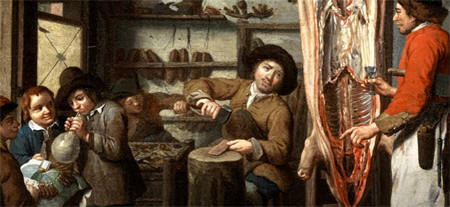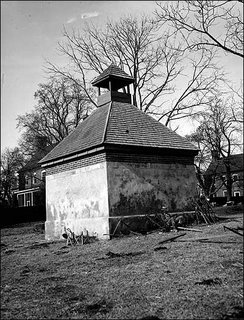| |
| |
|
|
|
| |
| |
"BY 1 DAYS KILLING HOGS" --
THE BUTCHER
Peter Pugh did a lot of different work for the Dupui
family, everything from killing hogs to hauling
wheat, bundling oats, weighing flour, cutting grass,
making plows, and priming wagon wheels. He
wasn't necessarily just a resident butcher.
But animals did need to be processed for food on the
frontier. So what types of animals were part
of the local diet? What can Dupui's ledger
tell us?
As cow's milk (20 shillings) was purchased by Daniel
Schoonmaker, we do know that dairy products were
part of the area diet. And as expected, both
purchases and sales of cows do appear in the ledger
record (as did sales of cow hides). Similarly,
with the large number of deerskins noted in these
ledger transactions, one can safely conclude that
deer meat was part of the local diet as well.
The
favorite meat of the populace, however, was
pork (with 725 pounds of "the other white
meat" sold). Second, in terms of weight
sold, was beef (at 217 pounds). Third, was
bacon (131 pounds).
While the 18th century was known to have had
butcher shops, we cannot find any specific
reference within Dupui's ledger to any such
establishment within this region. |
|
 |
 |
|
The
closest we come to the possibility of a
butcher shop is the occasional entry that
will state, for example, paid "by 14 pounds
of mutton".
All that we really know, to a high degree of
certainty, is that, per the ledger, area
hogs were killed in February... and if you
expected to have pork all year long, you
most certainly needed both a smokehouse and
preservative salt.
As pork, in fact, was sold on a year-round
basis (with sales recorded in months such as
May, June and October), one must necessarily
conclude that area smokehouses indeed were
constructed.
Ideally, one would have had a tub into which
fresh salted cuts would have been placed,
but the ledger doesn't report those in the
area until 1784. Presumably, pegs, nails,
hooks and chains were used for hanging the
meat.
|
|
|
| |
|
|
|
|
|
| |
|
|
|
| |
|
|
|
| |
|
|
| |
|
|
|
|